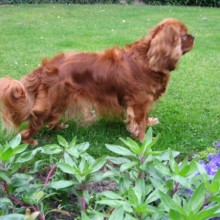Cavalier King Charles Spaniel
Lifestyle Needs

The Cavalier (‘Cavvy’) has the reputation of being a gentle, affectionate companion dog, but there will be variations in temperament as with all breeds. Possibly incorrectly placed in the Toy group of breeds, the Cavalier needs plenty of exercise and stimulation. The Cavalier’s long, fine coat needs daily attention to keep it tangle free and fur between the toes needs to be kept trim. Average lifespan 10 years.
Genetic Diversity
(Known as Coefficient of Inbreeding: 'COI'. It should be as low as possible.)
The UK Kennel Club breed average COI is 5.5% - See 'A Beginners Guide to COI'
Gene Pool Size
(Known as Effective Population Size: 'EPS')
111.2
EPS is a measure of how many individuals are contributing genetically to a breed population. It is a measure of the size of the gene pool in a breed. Lower than 100 is considered critical by conservationists and below 50 brings a breed close to extinction. For more information see the Kennel Club article.
Health and Welfare Problems due to Conformation
(Body shape and physical characteristics)
- The over long ears of the show type mean that when following a scent the ears can be trodden on and prone to collect dirt and debris
- Grass seeds can lodge in ears and toes
- The short nose of the Cavalier means that many of them suffer from brachycephalic airway syndrome which affects their breathing, cooling system and exercise tolerance.
- The Cavalier head shape has caused a disparity between the brain and skull volume causing Chiari-like malformation and Syringomyelia – a painful neurological disease.
- The head shape and size also causes dental overcrowding, bite disorders and dental disease
- The head shape also results in a shortened eustacian tube and obstructive tissue leading to the build up of mucus in the inner ear causing discomfort and partial deafness.
- Prominent eyes caused by shallow eye sockets can lead to eye injuries
BVA/KC Health Schemes: www.bva.co.uk/chs
- Eye disease: Multifocal Retinal Dysplasia (MRD) (litter screening); Hereditary cataract (HC) (annual testing); Multiple ocular defects (MOD) (litter screening)
- Hip Dysplasia: breed 5 year mean score 19.6 (parents should be lower)
- Chiari malformation Syringomyelia (CMSM) An extremely high incidence in this breed. Almost all Cavaliers have the Chiari malformation and at 6 years and older 70% will have SM. You are strongly advised to go to a breeder who uses the BVA/KC CMSM scheme
- Kennel Club Heart Scheme for MVD (parents and grandparents0
Identified by the UK Kennel Club as part of their Breed Health and Conservation Plan
Estimated Breeding Values (EBVs) : No EBVs are currently available for this breed
www.thekennelclub.org.uk/about-ebvs
DNA Tests Available
DogWellNet and IPFD Harmonisation of Genetic Testing for Dogs (HGTD)
www.dogwellnet.com/breeds
- Curly Coat Dry Eye
- Episodic Falling Syndrome
- Degenerative Myelopathy (DM)
Availability of a DNA test does not mean that it is always necessary or even desirable for breeders to use this test.
Other Breed-Specific Health Screening Schemes
- Mitral Valve Disease (MVD) Heart scheme: both parents clear of heart murmur at two and a half years and grandparents clear at 5 years. MVD has a very high incidence in the breed with 50% developing heart murmurs by the age of 5 years. Many Cavaliers will die prematurely from this disease.
- No dog should be bred before 2 and a half years of age
- Patella luxation test
Ask the breeder to show you the certificates for the above tests/screening for both parents. If any of the above tests have not been considered necessary by the breeder (and there may be good reasons), ask her to explain why.
Other Diseases Reported
(For which there are currently no genetic or screening tests for sire or dam)
- Pancreatitis
- Patellar luxation
- Epilepsy
- Primary secretory otitis media (Glue Ear)
- Fly catching, air licking and other neurological disorders
- Anal gland impaction
- Blood platelets
Ask the breeder about the medical history of the parents, grandparents and great grandparents. Consider carefully whether to purchase a puppy if some of these or other diseases are in the family line.
Ask about the breeder’s policy in cases of serious genetic diseases occurring to your puppy in later life. Good breeders will request to be informed of such events in order to improve future breeding decisions.
You are strongly advised to buy from a breeder who uses (or is prepared to use) the AWF Puppy Contract and Puppy Information Pack (PIP): www.puppycontract.org.uk
The breeder should also be familiar with the CFSG/DBRG Code of Practice for Dog Breeding